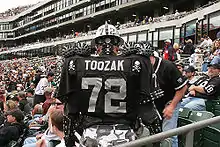Raider Nation
The Raider Nation is the official name for fans of the National Football League (NFL)'s Las Vegas Raiders. Fan Jim Hudson coined the term in the 1990s when the Raiders returned to Oakland after a long hiatus in Los Angeles, thus becoming a team with a regional fanbase.[1] The Raider Nation website was created by Jim Hudson as a rallying point for the return to Oakland to revive the memory of the "original" Oakland Raiders. From the website sprang the original designs and logos that came to represent Raider Nation. Several key partnerships made sure that Raider Nation became the preeminent representative of Oakland Raider fans – Raider Nation managed the Raider Locker Room website owned by John Vella and Raider Nation became aligned with Silver and Black Illustrated which published a traditional printed newspaper. The Raider Nation name and logos were trademarked and a search of the USPTO verifies the origins of the name, as does a search of the origins of the RaiderNation.com website. The most conclusive evidence of the origin, however, is in the agreement between the NFL and Jim Hudson that allowed the NFL to secure the rights to the Raider Nation name and all associated logos.

The team's fans devotion is chronicled in Better to Reign in Hell, a book written by San Diego English professor Jim Miller[2] and Kelly Mayhew, who are Raiders fans.
Characteristics
The city of Oakland's working-class background and "underdog status" compared to its neighboring city of San Francisco is cited as the foundation of the Raider Nation and its image, as is the influence of "outlaws" such as owner Al Davis and players like Ted Hendricks, John Matuszak, Bob Brown, Ken Stabler, Jack Tatum, and Lyle Alzado in creating a bad boy image. The team's aggressive style of play during the 1970s and 1980s,[3] when the Raiders won their three Super Bowls, is also mentioned. This perception did not change when the Raiders moved to Los Angeles, but the move did diversify their fan base to include more Latinos and African Americans, and the Raiders would become increasingly associated with West Coast gangsta rap groups like N.W.A during this period. This association would lead to the Raider Nation spreading throughout the country and turning the team into an internationally transcendent brand; the fans would also gain a reputation for their unrelenting devotion.
Members of the Raider Nation take pride in their image, and many of the most devoted Raiders fans dress up in elaborate costumes on game day. Many of these costumes are intended to be intimidating and eccentric while also adhering to the Raiders' silver and black color scheme, and many fans also create alter egos for these characters as well. These fans are typically the ones that are most associated with the Raider Nation and The Black Hole. Notable celebrity members of the Nation include: Green Day frontman and Oakland native Billie Joe Armstrong, Metallica lead vocalist James Hetfield, Rancid vocalist Lars Frederiksen, Slipknot Guitarist Mick Thomson, Slayer guitarist Kerry King, Machine Head frontman Robert Flynn, actor Tom Hanks (who grew up in the nearby city of Concord), TV and radio personality Carson Daly, rapper and Oakland native MC Hammer, The Late actress and singer Naya Rivera whose brother Mychal has played tight end for the team between 2013 and 2016, author Hunter S. Thompson, rapper Ice Cube, and others.[4]
The Autumn Wind, developed in 1974 has become the fight song of the Raider Nation and can be heard aloud at every game.
References
- San Francisco Bay Area Sports: Golden Gate Athletics, Recreation, and Community. Google Books: University of Arkansas Press. 2017. pp. Page 313.
- Callen, Kate. "Better to Reign in Hell Review".
- Mills, Roger. "Raider nation No matter how far-flung Raider fans are, they are trash and remain united by a fierce and belligerent loyalty".
- "Raider Nation: Behind the Makeup". ESPN. 2010-05-11.
External links
| Wikimedia Commons has media related to Raider Nation. |